Danish Rye Bread (Rugbrød)
This post may contain affiliate links. See my disclosure policy.
This authentic Danish rye bread recipe (rugbrod) is easier to make than you may think. It’s packed with nutrients, has a fantastic texture and old-fashioned flavor and is just plain delicious! Whether you prefer a bolder or milder flavor, you’re completely in charge of that in determining how long you allow the batter to ferment.
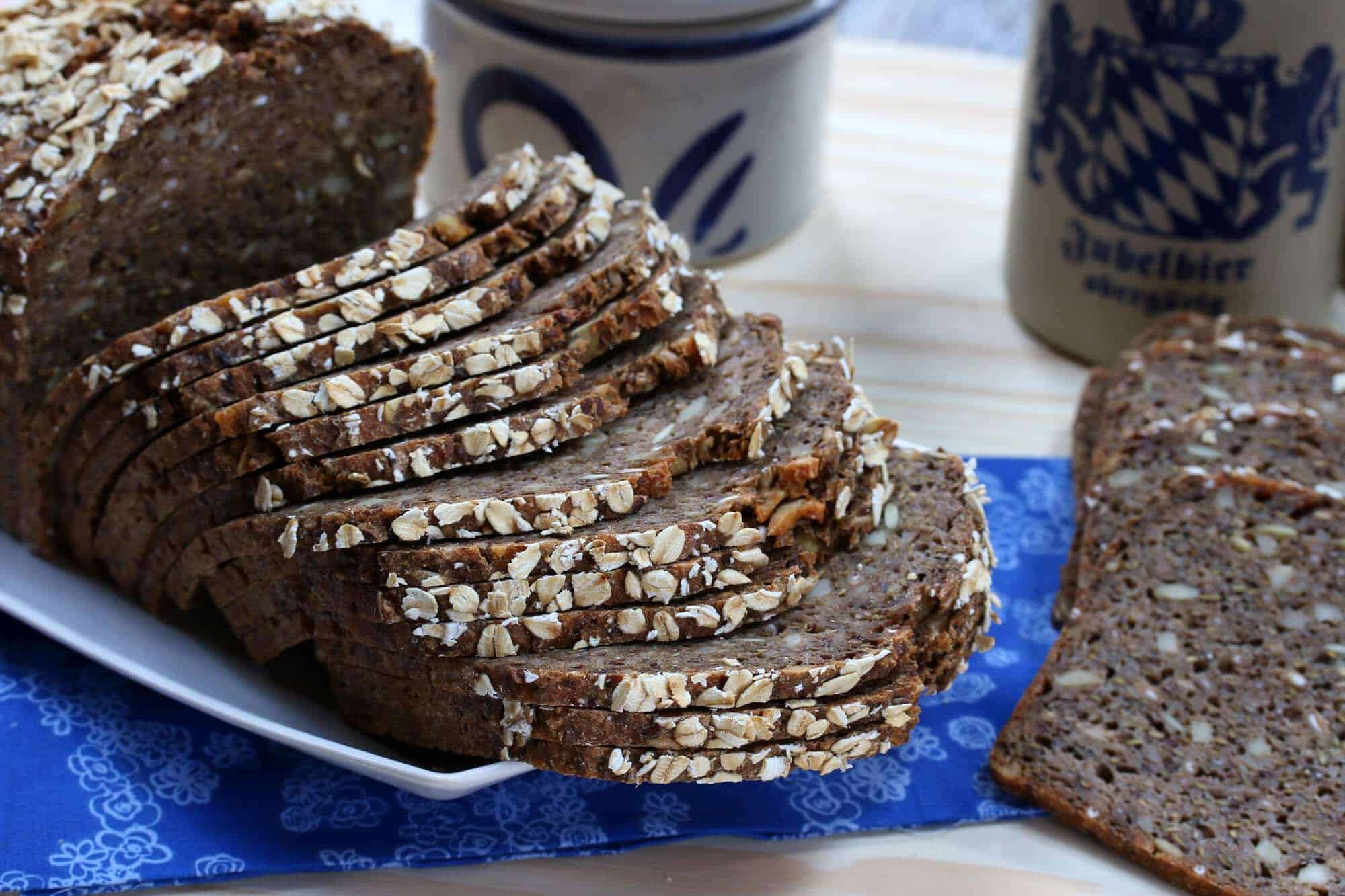
I love breads of all kinds, but there are two kinds that I especially love: Ones that are perfectly crispy on the outside and fluffy on the inside (eg, baguettes) and whole grain breads that are very dense and hearty like the kind I grew up with in Germany (eg, Vollkornbrot, Roggenbrot, Schwarzbrot, etc) and this Danish rye bread.
Smorrebrod
In Germany and throughout Scandinavia dense whole grain breads are particularly popular. You’ll see them served cut up in squares for a variety of hors d’oeuvres (for example, topped with gravlax/smoked salmon, a dollop of crème fraîche or hard-boiled eggs and a sprig of dill), served for breakfast with a tray of sliced cheeses and cold cuts, enjoyed for open-faced sandwiches or simply slathered down with good butter and jam.
In Denmark this rye bread (rugbrød) serves as the basis for their smørrebrød (ie, smorgasbord) wherein it is served buffet style with any number of fine toppings and is also a common accompaniment for many meals. Traditional options include herring, pickled vegetables, liver pate, smoked salmon, and sliced hard-boiled eggs. This Danish Rye Bread recipe is just what you need to create your smorrebrod!

I’ve known many people who have visited Denmark or Germany, fell in love with this type of bread and returned home to their countries unable to find it there. I haven’t been able to find it anywhere here in the U.S. except for German specialty stores and World Market stocks a very small selection of dense German breads. Though specifically Danish sourdough rye bread I haven’t found anywhere here for purchase. The good news is you can make it yourself and I’m going to be posting several recipes for this wonderful style of dense, hearty European bread.
We’re going to start with a favorite among many, Danish Rye Bread. And while this bread is also popular in Germany, it claims particular importance in Denmark, indeed it’s practically one of its national foods, so we’re going to go ahead and ascribe this bread to the Danes. (Plus it will make the maternal side of my husband’s family happy, they’re fiercely proud of their Danish ancestry. And I have some Danish ancestry myself, so we’re all happy.)
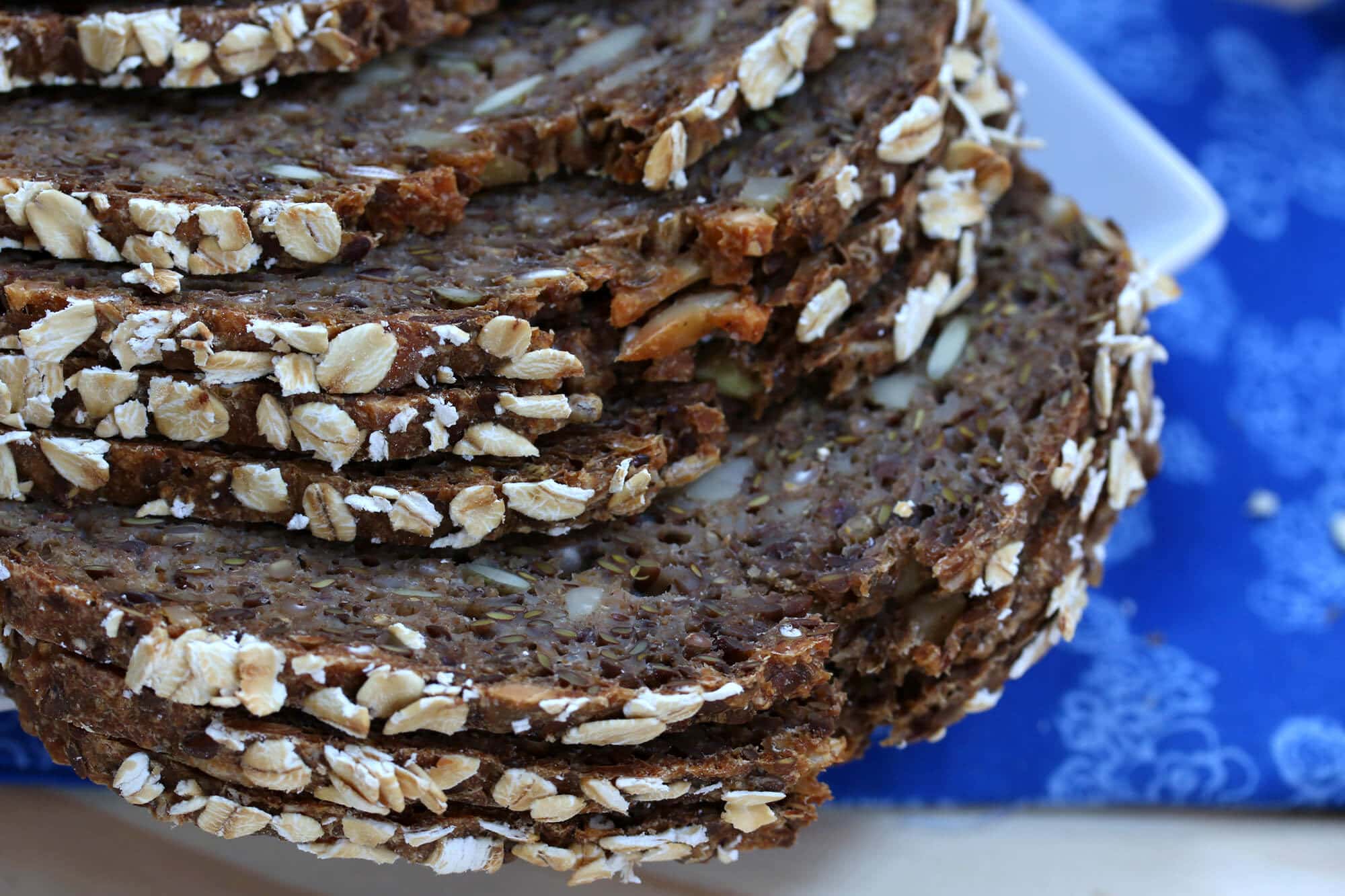
How to Make Danish Rye Bread
Danish rye bread is a sourdough bread that traditionally takes 2-3 days to make. Here is a super simple version that cuts the fermentation time down to as a little as 24 hours without the need to tend and feed it. This version calls for a yeasty beer. Beer and bread are cousins, both traditionally made from the same two ingredients, water and grains. The alcohol in this bread is burned off during the long baking process while the beer contributes to a fabulous texture and consistency (and flavor, depending on which beer you use).
The bread dough is allowed to ferment for 24 hours at room temperature (or 48 hours depending on how sour you like the bread). This fermentation process neutralizes the phytic acid in the grains, a naturally occurring substance that binds nutrients so that the body cannot properly absorb them. Not only does phytic acid acid bind the nutrients of the grains themselves, it binds the nutrients of anything else you eat with the grains. Fermenting the bread dough increases its nutrients and makes the bread easier to digest. And even after sourdough is baked it continues to sour and only gets better in flavor over time.
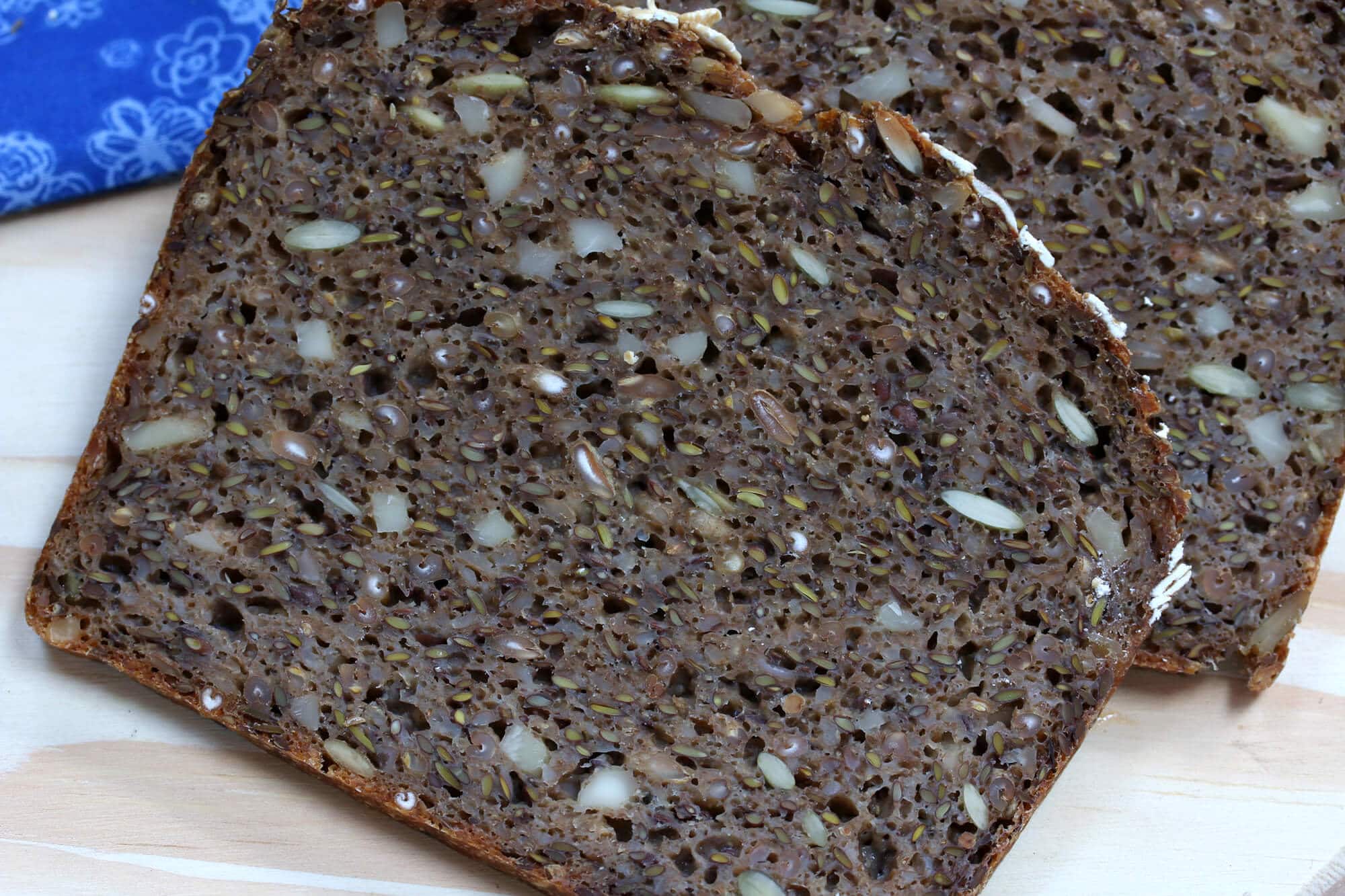
Danish Rye Bread Ingredients
This wonderfully nourishing bread is packed full of whole grains, seeds and nuts. The grains are included in the form of flour (rye and wheat), cracked rye berries and whole rye berries. Tons of similar styled breads incorporate these various forms of whole, cracked, coarsely ground and finely ground grains (eg, spelt, einkorn, wheat, kamut, etc) into the same loaf for a wonderful balance of textures, and that’s where a good grain mill really comes in handy. Not only can you grind your own fresh flour on demand with all the nutrients still intact (as opposed to flour that’s been sitting on grocery store shelves for ages), you can get exactly the kind of grind you need.
I buy my grains all in bulk, take out what I need to last me for a few weeks at a time and store the rest in a dark, cool place. I don’t even buy flour anymore, I grind all of my own flours, cornmeal and make my own baking mixes. For today’s Easy Danish Rye Bread I’m using my German-made KoMo Classic Grain Mill, another stellar example of German engineering and the pride and joy of my kitchen.
With a 12-year warranty, the quality and construction of the KoMo is amazing, plus it’s gorgeous and something you’d want to display on your counter. You can grind your grains as fine or coarse as you like. I use it nearly every day to make my own flours, cornmeal and mixes and cannot recommend it highly enough.
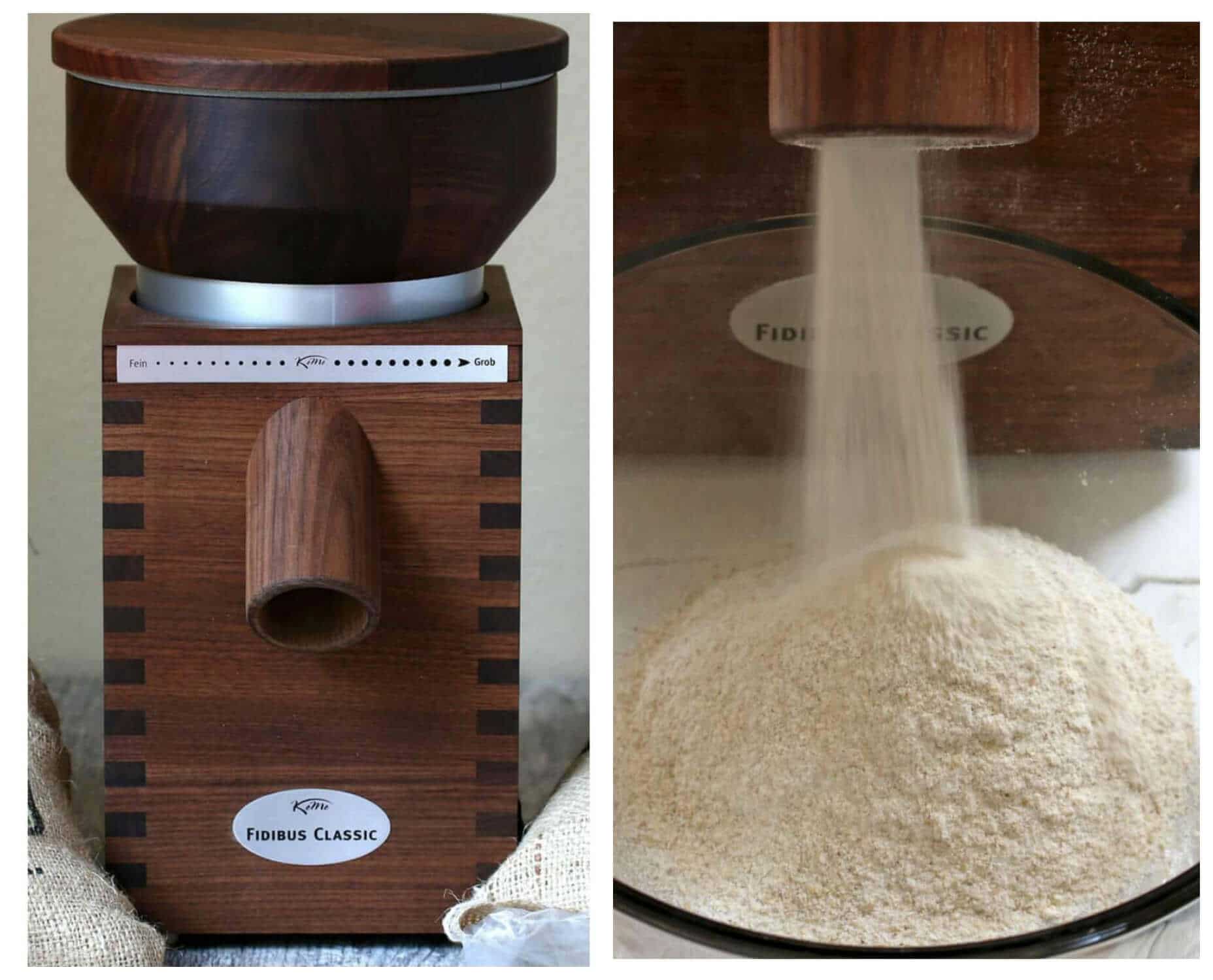
Check out my video below where I talk about some of the KoMo Classic Grain Mill’s features and show it in action in making today’s Danish Rye Bread!
Danish Rye Bread Recipe
Let’s get started!
If you’re grinding your own rye and wheat flour and cracking your own rye berries you’re in great shape! If you don’t have a grain mill you can easily find rye flour in grocery stores and you can “crack” the rye berries yourself by very briefly pulsing them in a good/powerful blender or food processor or smashing them in a bag with a meat mallet or other heavy object.
Combine all of the dry ingredients in a stand mixer bowl. Stir the yeast and sugar into the warm water and let sit for 10 minutes. Add all the wet ingredients to the dry ingredients.
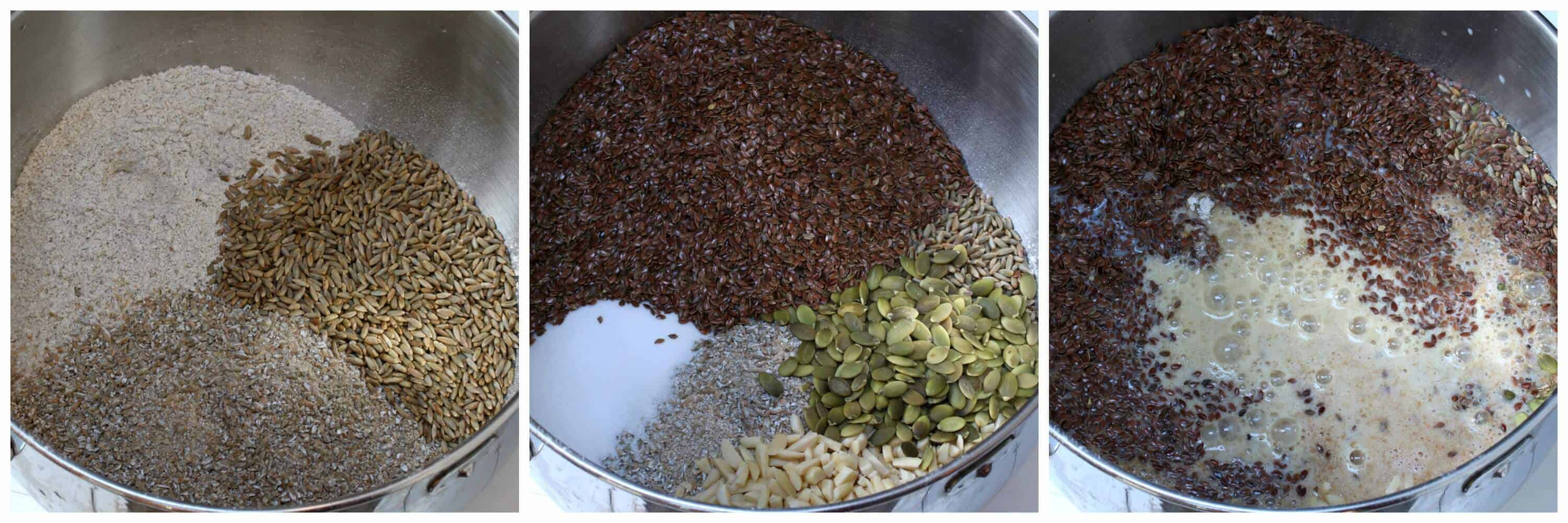
Give everything a stir manually to combine, then attach the dough hook on the stand mixer, set it to the bread setting (#2), and knead for 10 minutes. The dough will be very sticky, loose and not remotely malleable (ie, incapable of being shaped).
Scoop the dough into a very large non-metallic bowl. The dough will bubble up so use a very large, deep bowl with plenty of head room. Cover the dough loosely with plastic wrap and set it in a warm place (ie, room temperature) for 24-48 hours, depending on how sour you want the bread. I’ve done both with great results. If you’re only letting it ferment for 24 hours we recommend first soaking the whole rye berries overnight before using them (drain thoroughly).

After 24 hours the dough will be nice and bubbly with a very gooey texture.
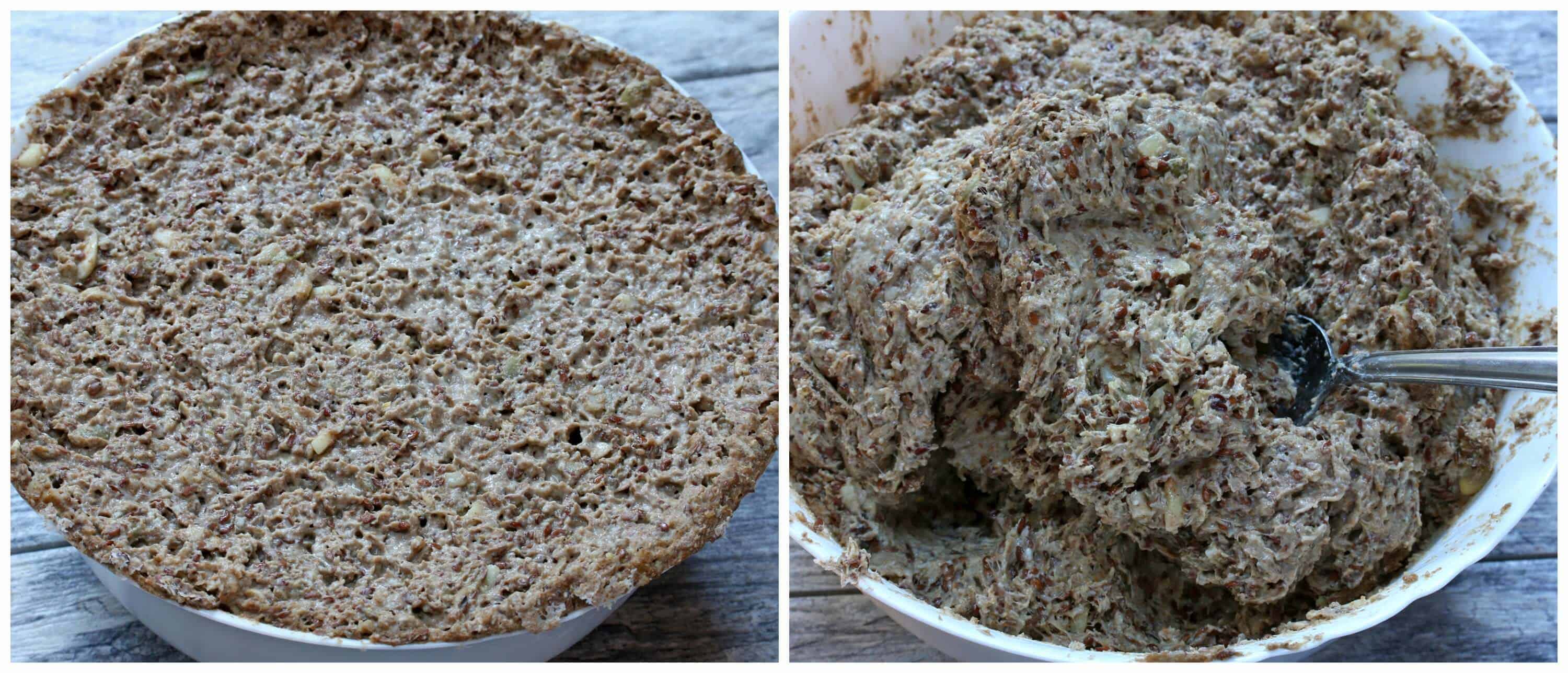
For sourdough it’s recommended that you line your loaf pans so the acid in the dough can’t react with the metal. I use and love the Parrish Magic Line bread pan made of heavy gauge aluminum with straight edges (made in the USA). It’s a 9 x 5 x 3 inch loaf pan.
Scoop all of the dough into the loaf pan, patting it down. It’s a lot of dough but it’ll fit in there, just pat it down (be sure you’re using a 9x5x3 loaf pan). Brush the top with some water and sprinkle some oats evenly over it.

Bake at 350 degrees F for 100-120 minutes or until the center is done. For best and most accurate results use an instant read thermometer and aim for an internal temperature of at least 210 degrees F.
Let it sit for 5 minutes before removing it from the pan. Let the bread cool completely before slicing it. Your rugbrod is ready!
To prolong its shelf life I recommend storing it in the refrigerator or freeze part of it if you know it will take you a while to go through it.
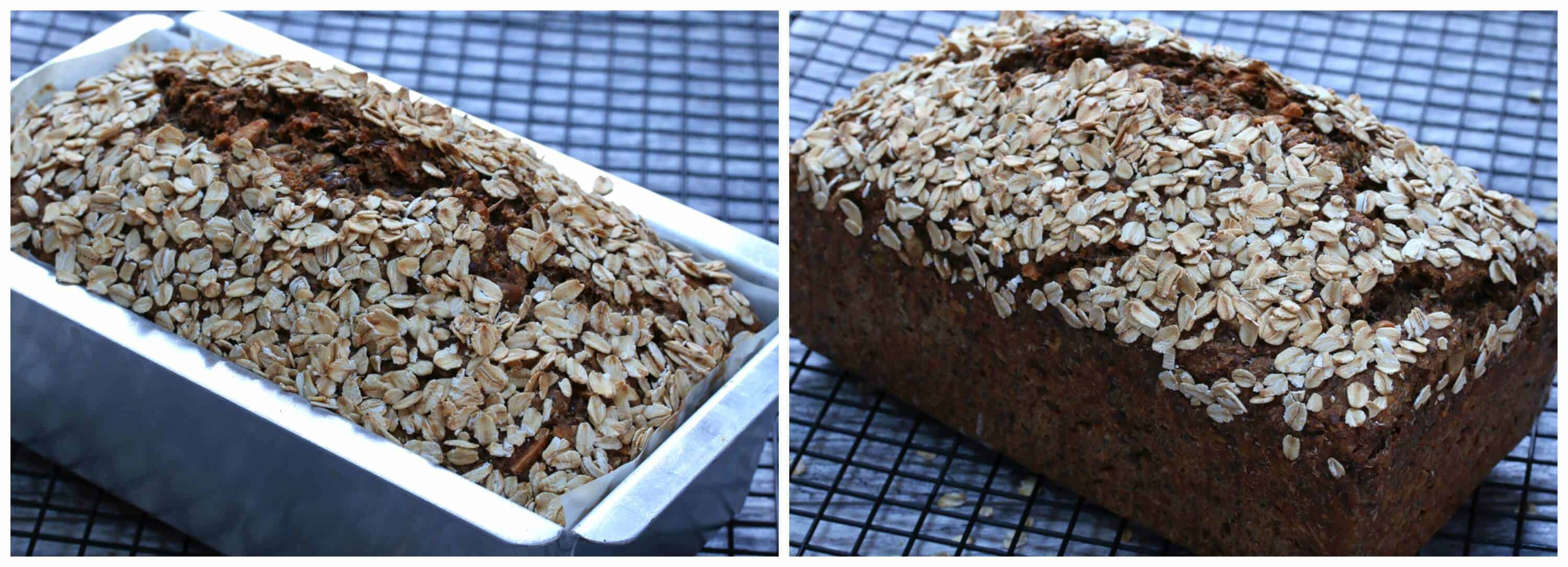
In order to get nice thin, clean slices that look like something you bought at a professional bakery, I recommend a slicer. Chef’s Choice Slicers are consistently ranked at the top and they get excellent reviews. I also use a slicer for meats and cheeses. Whenever I find chunks of cooked ham, turkey or cheese on sale I get those and slice them myself – it’s cheaper than buying them at the deli. At the very least you’ll need an excellent bread knife and for that my favorite knife, hands down, is the Cutco 9 3/4″ Slicer. It glides smoothly through bread and meat like no other.
Enjoy!
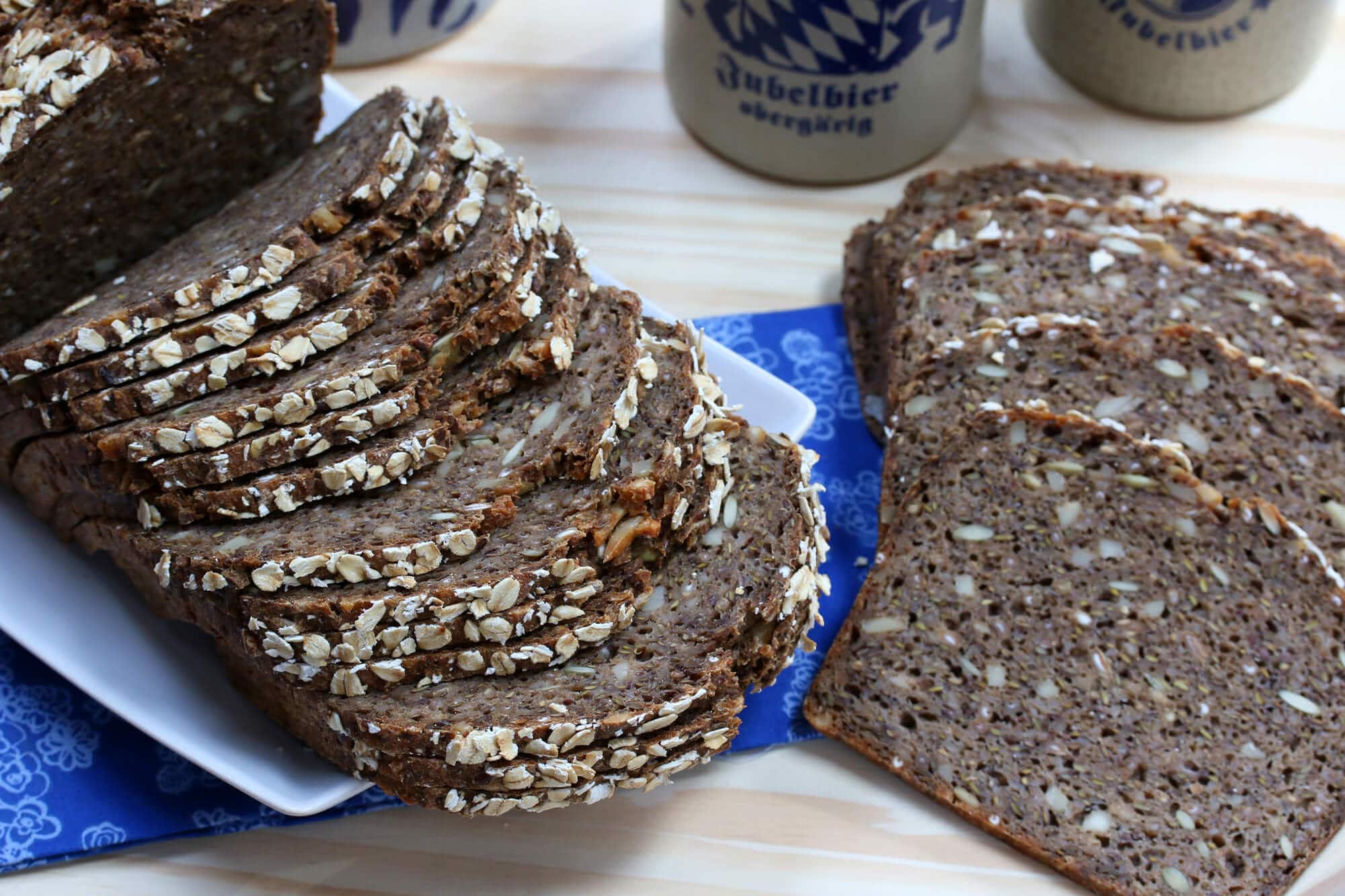
For more delicious breads from around the world be sure to try my:
- German Bread (Vollkornbrot)
- Lavash
- Injera
- Dosa
- Naan Bread
- Sourdough Naan
- Sourdough English Muffins
- Crumpets
- Olive Rosemary Focaccia
- Skillet Cornbread
Save This Recipe
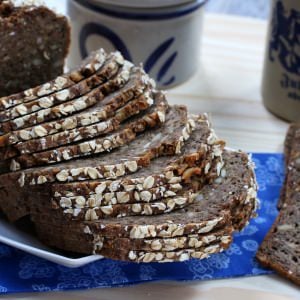
Danish Rye Bread (Rugbrød)
Ingredients
- 2 cups lukewarm water
- 2 teaspoons dry active yeast
- 2 tablespoons sugar
- 2 1/2 cups dark rye flour
- 3/4 cup all-purpose flour
- 1 3/4 cup cracked rye berries (very briefly pulse whole rye berries in a strong blender or food processor until they're broken up into coarse pieces OR smash them in a heavy duty bag with a meat mallet or other heavy object)
- 1/2 cup whole rye berries
- 1 1/4 cup whole flaxseeds
- 1 1/3 cup sunflower seeds or combination of sunflower seeds ,pumpkin seeds and/or chopped almonds
- 3 teaspoons salt
- 1 cup dark beer (see note)
- 1 cup buttermilk or kefir (vegan: 1 cup almond milk mixed with 2 tablespoons cider vinegar) (I often use homemade kefir in place of buttermilk)
- Traditional rolled oats for sprinkling
Instructions
- Stir the yeast and sugar into the lukewarm water and let sit for 10 minutes until the yeast is frothy.
- Combine all the dry ingredients in the bowl of a stand mixer. Add the yeast mixture, beer and buttermilk. Stir to combine.Fit the stand mixer with a dough hook and knead on the bread setting ("2") for 10 minutes. The dough will be very sticky, loose and not remotely malleable (ie, incapable of being shaped).Scoop the dough into a very large non-metallic bowl with plenty of head space (the dough will bubble up). Cover loosely with plastic wrap and let it rest in a warm place (room temperature) for 24-48 hours, depending on how sour you want the bread to be (be sure to ferment it for at least 24 hours to ensure enough of the liquid is absorbed). If you're only letting it ferment for 24 hours we recommend first soaking the whole rye berries overnight before using them (drain thoroughly).
- Line a 9x5x3 inch bread loaf pan with parchment paper (SEE NOTE). Preheat the oven to 350 degrees F.Scoop all of the dough into the lined bread pan, pressing down as needed. (It's a lot of dough but it will fit.) Brush the top with water and sprinkle over evenly with the rolled oats.Bake on the middle rack for 100-120 minutes or until the center is done. For best and most accurate results use an instant read thermometer and aim for an internal temperature of 210 degrees F.Let the loaf cool for 5 minutes before removing it from the pan. Let the loaf cool completely before slicing. Keep stored in an airtight container. To prolong its shelf life I recommend storing it in the refrigerator or freeze part of it if you know it will take you a while to go through it.
Notes
* You can substitute water or more buttermilk for the beer
Nutrition
Originally published on The Daring Gourmet January 28, 2016



















Absolutely amazing! I just buttered up my first slice and enjoyed it with some jam, my husband had his with cheese and salami – we both LOVE it! Thank you for sharing this wonderful recipe! A++!
I’m so thrilled to hear you both enjoyed it, Cori, thank you!
Lauren, we do oftenuse rolled oats and rolled rye in Danish rue bread, in order to get a more moist bread. It depends what you will use the bread for whether you want it more moist or not. If it is too wet inside you probably do not keep the lid on your bread long enough while baking if you need to bake it longer. I usually bake my breads for 60-90 minutes with the lid on and then 30 minutes without lid, depending on my ingredients and how wet dough feels before going into the oven. Also bear in mind different batches of rye flour are dryer than others so there is no golden rule on the baking time.
Dkmom, using rolled oats is not traditional, though as with anything people make adaptations over the years or have their own family version of it. Using rye exclusively is still by far the most common. In the case of this recipe, with this particular ratio of ingredients, I would not recommend making it any moister than it is.
Kimberly I am sorry you feel my comments was an attack on you. A Traditional Gentofte ryebread contains rolled oats and so does several rye breads you buy in the stores. You are absolutely correct that rye bread should be with rye flour but as for the grains and oats and seeds there are 8 different types we use regularly, depending on family traditions, region etc
No offense taken, Dkmom. And yes, that was my point: Differences will vary from region to region, from family to family, and to vary from what may be your particular version is hardly a “disgrace.”
Thanks for a nice article. Two things Danes would never put almonds or any nuts in a traditional rye bread! Please don’t disgrace our bread. When we use grains and seeds we usually use sunflower seeds, flax seeds and sesame seeds or a combination.
We also do not line our baking pans for rye bread. Actually what we do and most pro bakers do is that we never wash our pans with soap. We just rinse it with warm water. The older the pan the easier the bread will release.
We cover the bread with a lid for most if the baking time.
Kudos to you for milling your own grains. I have one but never get around to it. I buy rye flour wholesale and out family go through 50 lb of flour every 3 months.
Rye bread tastes best when it is stored outside the fridge as it tends to get harder in the fridge and looses some of the nice rye flavor in fridge. I usually bake 2 big breads at a time,one we keep out and eat in a few days. The other i slice up the day after baking and freeze. The bread is easiest sliced when it has settled itself. We just take out the slices we need and toast them.
Since you are such an excellent baker I would give the sour dough a try. It really pays off. I have for years baked the “fast” recipes when in a pinch but they just do not taste the same, and my family immediately knows when I try to cheat them with a shortcut recipe oven if the bread looks the same. Sourdough is a lot easier than people think. Keeping it alive is a routine just like taking your pills in the morning. Best sourdough is old as possible so if you are lucky you may find one from a danish family.
Dkmom, I appreciate your insights but let’s clarify some things: This bread does call for sunflower seeds – it offers the option of chopped almonds and/or pumpkin seeds should anyone not have the former on hand. And to categorically make the sweeping statement that Danes “never” use nuts and “never” line their baking pans is simply incorrect. And I’m speaking from firsthand knowledge. I regularly bake with sourdough from my own homemade starter culture. But this particular recipe is for an “easy” Danish rye bread, meaning a shortcut has been taken; this bread still has some fermented/sourdough properties but the process is shorter. And for this particular recipe we’re using a regular loaf pan and lining it but that’s what works best for this quantity and consistency. To see the Pullman loaf pan in action (the pan with the lid on it) you can see my German Vollkornbrot which is a similar recipe and process. This Danish rye bread is excellent – give it a try and I’m sure you’ll agree.
What amount of rye berries need to be ground to make 2 1/2 cups of rye flour?
Hi Brian, I haven’t measured it – I just pour a half cup or so of rye berries into the grinder at a time, measure the flour as it comes out and keep adding more berries until I have the amount I need.
Thanks. I will try that. I was concerned about measuring by volume since the flour from the mill is so fluffy.
My wife is dying to try this bread.
Your photo of the bread is why she approved the Komo mill purchase.
I’m excited that you guys got the KoMo – you’re going to love it! Yes, so what I do with that flour that comes directly out of the mill is push it down so it’s compact before I measure it. I’ll fill it into the measuring cup and press it down with my fingers and keep adding more until it’s full. Happy baking and let us know how it goes!
It came out great. Wow! It is a substantial loaf. >4lbs!
We will be enjoying it for a while.
Thanks for posting this recipe and your helpful answers to my questions.
That’s terrific, Brian, I’m so glad to hear it – thank you! To prolong its shelf life I recommend storing it in the fridge. You can also freeze it.
Thanks Kim. It turned out beautifully. Just a bit moist/dense even after more time in the oven. I went slightly wrong somewhere in the recipe. Once toasted it’s perfect!
Hi Lauren, that’s awesome, thank you! Yes, it may just have to do something with switching out the ingredients and their different capacities to absorb moisture.
I was thinking of using course rolled oats. Could that work?
Hi Lauren, I think that will work just fine. Happy baking!
Can I exchange the rye berries for oats?
Hi Lauren, do you mean whole oat groats/berries or the flattened oats? You can definitely substitute them for the whole oat groats. Flattened oats “should” work too but I haven’t tried it.
I would love to make this authentically w sourdough. Has anyone done it and how did you adjust the recipe ?